tyre pressure FIAT PALIO 2003 178 / 1.G India Version Owners Manual
[x] Cancel search | Manufacturer: FIAT, Model Year: 2003, Model line: PALIO, Model: FIAT PALIO 2003 178 / 1.GPages: 156, PDF Size: 6.27 MB
Page 76 of 156

75
CONTAINING RUNNING COSTS
AND POLLUTION
Tyres
Tyre pressure should be checked at
least once every four weeks: if the
pressure is too low fuel consumption
increases as the resistance to the
rolling movement of the tyre is
greater. In this state, tyre wear is in-
creased and handling suffers which will
effect safety.
Unnecessary loads
Do not travel with too much load in
the boot. The weight of the car (above
all in the urban traffic)and its trim
greatly effects consumption and sta-
bility.
Roof rack/ski rack
Remove roof racks and ski racks
from the roof of the car as soon as
they are no longer needed. These ac-
cessories reduce the aerodynamic
penetration of the car and will increase
consumption.
Electrical devices
Use electric devices for the neces-
sary time only. The heated rear win-
dow, additional lights, windscreen
wipers, heater, fan of the heating sys-
tem require large amounts of elec-
tricity and increasing the request for
power will also increase fuel con-
sumption (up to +25% when driving in
towns). Some suggestions which may help
you to keep the running costs of the
car down and lower the amount of
toxic emissions released into the at-
mosphere are given below.
GENERAL
CONSIDERATIONS
Car maintenance
The overall state of the car is an im-
portant factor which has a marked in-
fluence over fuel consumption and dri-
ving comfort and on the life span of
your car. For this reason care should
be taken to maintain your car by car-
rying out the necessary checks and
regulations in accordance with the
specifications given in the service
schedule (see sections: spark plugs,
idling, air cleaners, timing).
64-79 03/03/2003 06:45 PM Page 75
Page 79 of 156
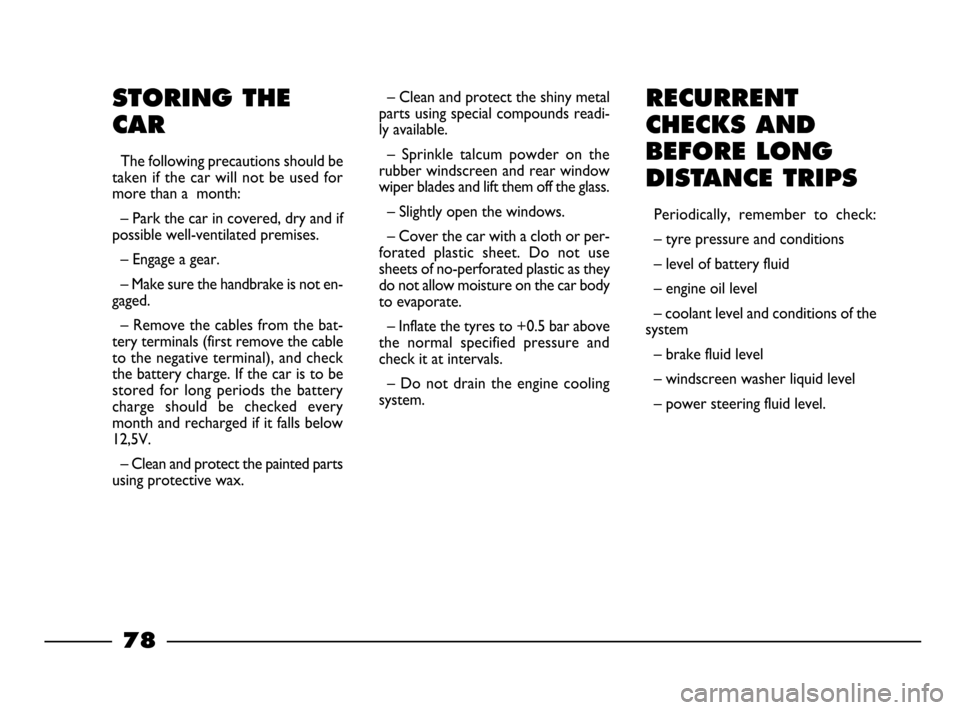
78
RECURRENT
CHECKS AND
BEFORE LONG
DISTANCE TRIPS
Periodically, remember to check:
– tyre pressure and conditions
– level of battery fluid
– engine oil level
– coolant level and conditions of the
system
– brake fluid level
– windscreen washer liquid level
– power steering fluid level.
STORING THE
CAR
The following precautions should be
taken if the car will not be used for
more than a month:
– Park the car in covered, dry and if
possible well-ventilated premises.
– Engage a gear.
– Make sure the handbrake is not en-
gaged.
– Remove the cables from the bat-
tery terminals (first remove the cable
to the negative terminal), and check
the battery charge. If the car is to be
stored for long periods the battery
charge should be checked every
month and recharged if it falls below
12,5V.
– Clean and protect the painted parts
using protective wax.– Clean and protect the shiny metal
parts using special compounds readi-
ly available.
– Sprinkle talcum powder on the
rubber windscreen and rear window
wiper blades and lift them off the glass.
– Slightly open the windows.
– Cover the car with a cloth or per-
forated plastic sheet. Do not use
sheets of no-perforated plastic as they
do not allow moisture on the car body
to evaporate.
– Inflate the tyres to +0.5 bar above
the normal specified pressure and
check it at intervals.
– Do not drain the engine cooling
system.
64-79 03/03/2003 06:45 PM Page 78
Page 83 of 156
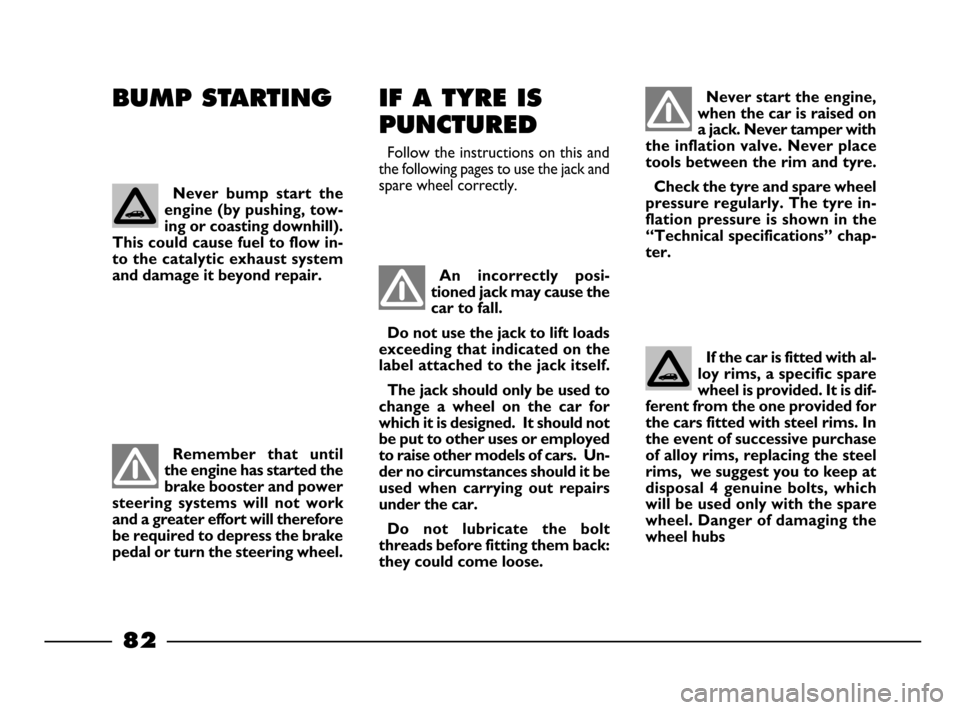
82
BUMP STARTING IF A TYRE IS
PUNCTURED
Follow the instructions on this and
the following pages to use the jack and
spare wheel correctly.
Remember that until
the engine has started the
brake booster and power
steering systems will not work
and a greater effort will therefore
be required to depress the brake
pedal or turn the steering wheel.
An incorrectly posi-
tioned jack may cause the
car to fall.
Do not use the jack to lift loads
exceeding that indicated on the
label attached to the jack itself.
The jack should only be used to
change a wheel on the car for
which it is designed. It should not
be put to other uses or employed
to raise other models of cars. Un-
der no circumstances should it be
used when carrying out repairs
under the car.
Do not lubricate the bolt
threads before fitting them back:
they could come loose.
Never start the engine,
when the car is raised on
a jack. Never tamper with
the inflation valve. Never place
tools between the rim and tyre.
Check the tyre and spare wheel
pressure regularly. The tyre in-
flation pressure is shown in the
“Technical specifications” chap-
ter.
Never bump start the
engine (by pushing, tow-
ing or coasting downhill).
This could cause fuel to flow in-
to the catalytic exhaust system
and damage it beyond repair.
If the car is fitted with al-
loy rims, a specific spare
wheel is provided. It is dif-
ferent from the one provided for
the cars fitted with steel rims. In
the event of successive purchase
of alloy rims, replacing the steel
rims, we suggest you to keep at
disposal 4 genuine bolts, which
will be used only with the spare
wheel. Danger of damaging the
wheel hubs
80-103 03/03/2003 06:49 PM Page 82
Page 86 of 156

85
10)Fit the wheel cup in order that
the biggest hole
A-fig. 8is aligned with
the bolt fixing the wheel. When fitting
the wheel cup make sure that the sym-
bol
Y, printed on the internal part of
the cup, is aligned with the inflation
valve.
11)Fit the last three bolts and tight-
en them using the wrench provided,
fig. 9.
12)Wind down the jack to lower
the vehicle and remove the jack.
13)Fasten bolts completely, work-
ing in a criss-cross fashion as shown in
fig. 10. Tightening torque: 86 Nm.
14)Arrange the punctured tyre in
the spare wheel compartment and se-
cure it with the locking device
A-fig.
11
.
fig. 7
P4E01754
15)Lower the carpet.
16)Put back the jack, the operating
handle and the wheel bolt wrench in-
to the tool bag.
17)Secure the tool bag to the in-
ternal boot wall with the relevant re-
taining belts.
fig. 8
P4E02176
fig. 9
P4E02377
IMPORTANT As soon as possible:
have the punctured tyre repaired and
mount it on the car thus limiting the
distance travelled with the spare
wheel.
IMPORTANT Check the inflation
pressure of the tyres and the spare
wheel regularly.
fig. 10
P4E02178
fig. 11
P4E02375
80-103 03/03/2003 06:49 PM Page 85
Page 106 of 156
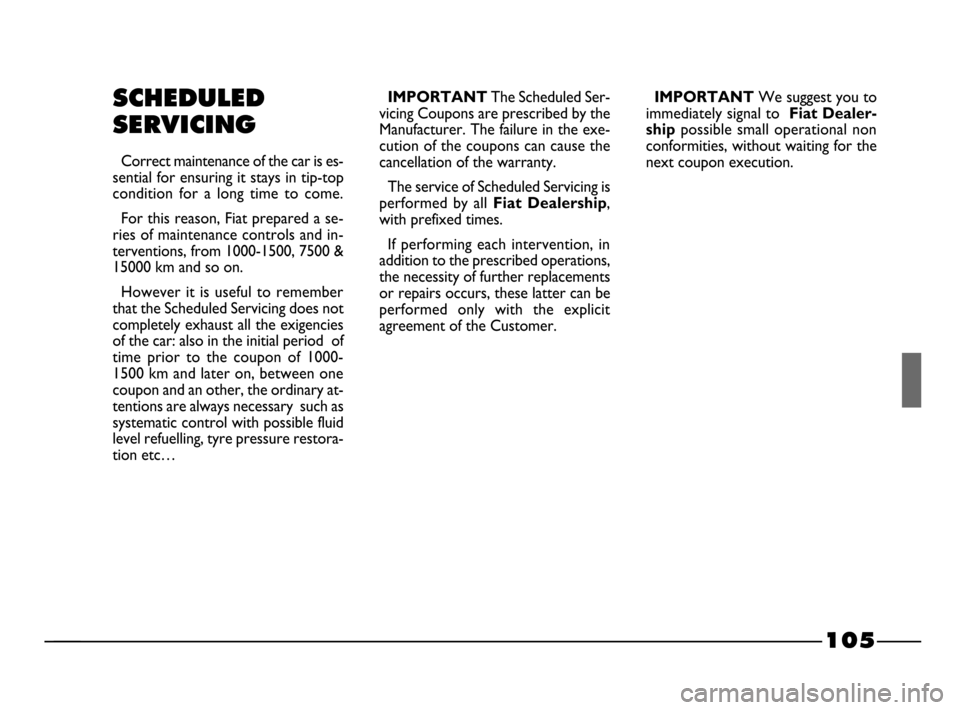
105
SCHEDULED
SERVICING
Correct maintenance of the car is es-
sential for ensuring it stays in tip-top
condition for a long time to come.
For this reason, Fiat prepared a se-
ries of maintenance controls and in-
terventions, from 1000-1500, 7500 &
15000 km and so on.
However it is useful to remember
that the Scheduled Servicing does not
completely exhaust all the exigencies
of the car: also in the initial period of
time prior to the coupon of 1000-
1500 km and later on, between one
coupon and an other, the ordinary at-
tentions are always necessary such as
systematic control with possible fluid
level refuelling, tyre pressure restora-
tion etc…
IMPORTANTThe Scheduled Ser-
vicing Coupons are prescribed by the
Manufacturer. The failure in the exe-
cution of the coupons can cause the
cancellation of the warranty.
The service of Scheduled Servicing is
performed by all
Fiat Dealership,
with prefixed times.
If performing each intervention, in
addition to the prescribed operations,
the necessity of further replacements
or repairs occurs, these latter can be
performed only with the explicit
agreement of the Customer.
IMPORTANT We suggest you to
immediately signal to
Fiat Dealer-
ship
possible small operational non
conformities, without waiting for the
next coupon execution.
104-127 03/03/2003 06:53 PM Page 105
Page 109 of 156
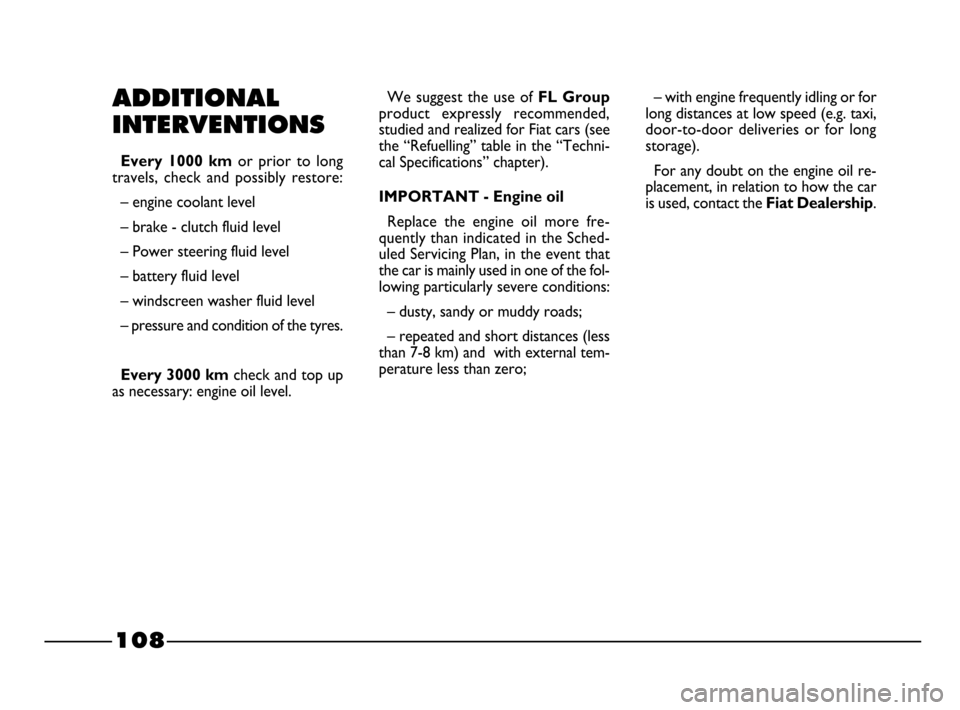
108
ADDITIONAL
INTERVENTIONS
Every 1000 kmor prior to long
travels, check and possibly restore:
– engine coolant level
– brake - clutch fluid level
– Power steering fluid level
– battery fluid level
– windscreen washer fluid level
– pressure and condition of the tyres.
Every 3000 kmcheck and top up
as necessary: engine oil level.We suggest the use of
FL Group
product expressly recommended,
studied and realized for Fiat cars (see
the “Refuelling” table in the “Techni-
cal Specifications” chapter).
IMPORTANT - Engine oil
Replace the engine oil more fre-
quently than indicated in the Sched-
uled Servicing Plan, in the event that
the car is mainly used in one of the fol-
lowing particularly severe conditions:
– dusty, sandy or muddy roads;
– repeated and short distances (less
than 7-8 km) and with external tem-
perature less than zero;– with engine frequently idling or for
long distances at low speed (e.g. taxi,
door-to-door deliveries or for long
storage).
For any doubt on the engine oil re-
placement, in relation to how the car
is used, contact the
Fiat Dealership.
104-127 03/03/2003 06:53 PM Page 108
Page 122 of 156
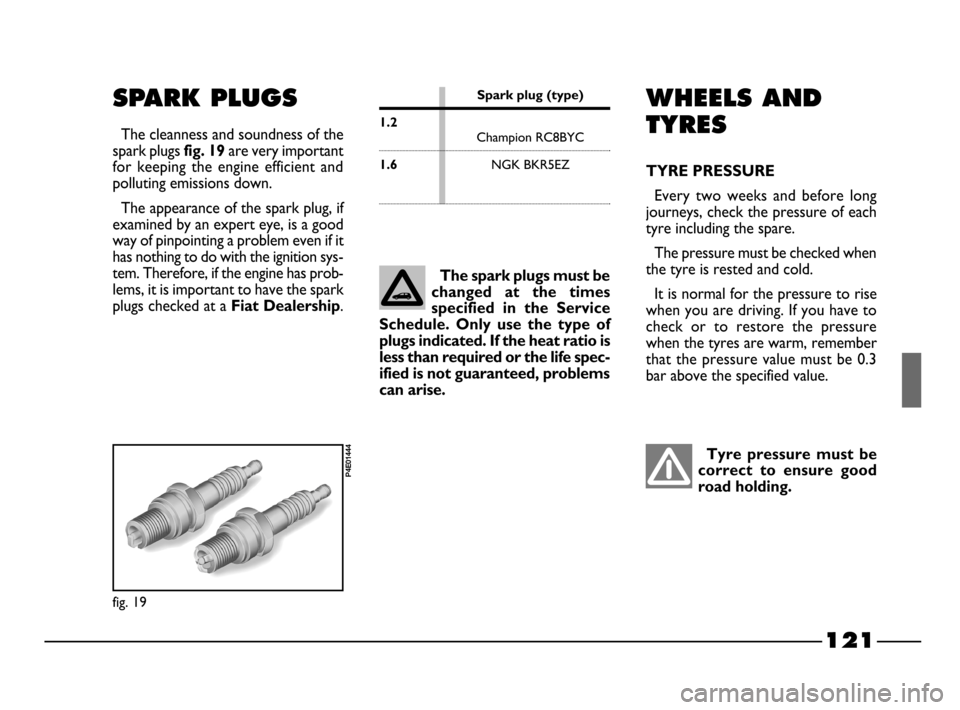
121
SPARK PLUGS
The cleanness and soundness of the
spark plugs
fig. 19 are very important
for keeping the engine efficient and
polluting emissions down.
The appearance of the spark plug, if
examined by an expert eye, is a good
way of pinpointing a problem even if it
has nothing to do with the ignition sys-
tem. Therefore, if the engine has prob-
lems, it is important to have the spark
plugs checked at a
Fiat Dealership.
The spark plugs must be
changed at the times
specified in the Service
Schedule. Only use the type of
plugs indicated. If the heat ratio is
less than required or the life spec-
ified is not guaranteed, problems
can arise.
Spark plug (type)
1.2
Champion RC7BMCChampion RC8BYC
1.6NGK BKR5EZ
Champion RC10YCC
Bosch FR8DE
fig. 19
P4E01444
WHEELS AND
TYRES
TYRE PRESSURE
Every two weeks and before long
journeys, check the pressure of each
tyre including the spare.
The pressure must be checked when
the tyre is rested and cold.
It is normal for the pressure to rise
when you are driving. If you have to
check or to restore the pressure
when the tyres are warm, remember
that the pressure value must be 0.3
bar above the specified value.
Tyre pressure must be
correct to ensure good
road holding.
104-127 03/03/2003 06:53 PM Page 121
Page 123 of 156
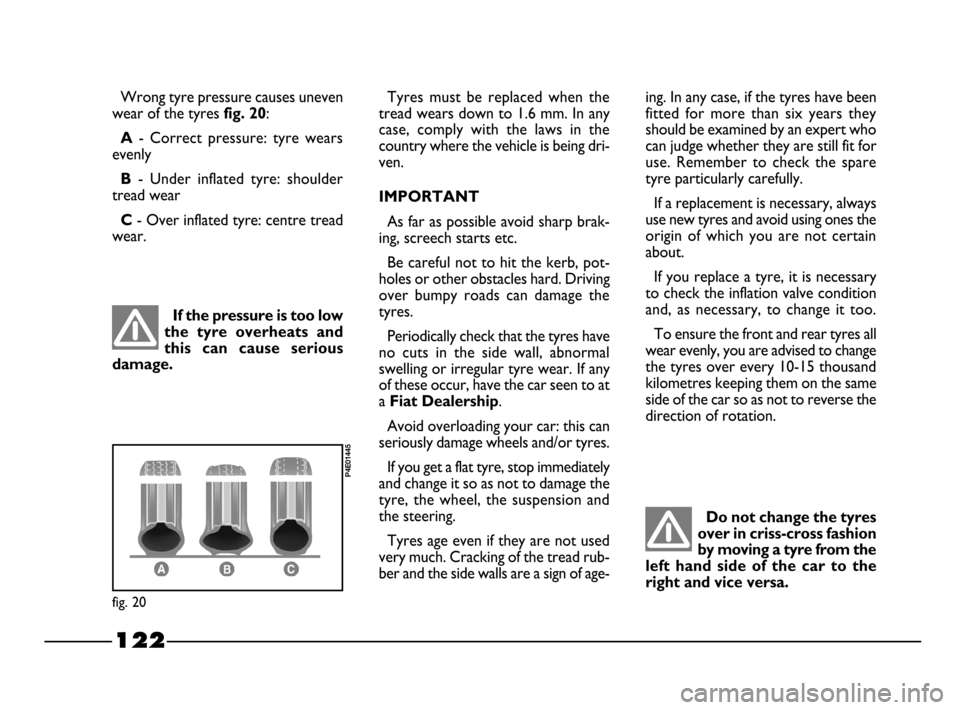
122
Do not change the tyres
over in criss-cross fashion
by moving a tyre from the
left hand side of the car to the
right and vice versa.
Wrong tyre pressure causes uneven
wear of the tyres
fig. 20:
A- Correct pressure: tyre wears
evenly
B- Under inflated tyre: shoulder
tread wear
C- Over inflated tyre: centre tread
wear. Tyres must be replaced when the
tread wears down to 1.6 mm. In any
case, comply with the laws in the
country where the vehicle is being dri-
ven.
IMPORTANT
As far as possible avoid sharp brak-
ing, screech starts etc.
Be careful not to hit the kerb, pot-
holes or other obstacles hard. Driving
over bumpy roads can damage the
tyres.
Periodically check that the tyres have
no cuts in the side wall, abnormal
swelling or irregular tyre wear. If any
of these occur, have the car seen to at
a
Fiat Dealership.
Avoid overloading your car: this can
seriously damage wheels and/or tyres.
If you get a flat tyre, stop immediately
and change it so as not to damage the
tyre, the wheel, the suspension and
the steering.
Tyres age even if they are not used
very much. Cracking of the tread rub-
ber and the side walls are a sign of age-
If the pressure is too low
the tyre overheats and
this can cause serious
damage.
fig. 20
P4E01445
ing. In any case, if the tyres have been
fitted for more than six years they
should be examined by an expert who
can judge whether they are still fit for
use. Remember to check the spare
tyre particularly carefully.
If a replacement is necessary, always
use new tyres and avoid using ones the
origin of which you are not certain
about.
If you replace a tyre, it is necessary
to check the inflation valve condition
and, as necessary, to change it too.
To ensure the front and rear tyres all
wear evenly, you are advised to change
the tyres over every 10-15 thousand
kilometres keeping them on the same
side of the car so as not to reverse the
direction of rotation.
104-127 03/03/2003 06:53 PM Page 122
Page 129 of 156

TECHNICAL SPECIFICATIONS
Motor and engineering enthusiasts as well as
those “in the trade” will probably start reading from
this point in the handbook. This, in fact, is where a
section jam-packed with facts, figures, formulae,
measurements and tables begins.
In a sense, it is Fiat Palio’s identity card. A docu-
ment that introduces the car and explains in techni-
cal jargon all the features that go together to make it
a model designed to give you superlative driving sat-
isfaction.CAR IDENTIFICATION DATA ........................... PAGE 129
ENGINE CODES -
BODYWORK PAINT IDENTIFICATION
PLATE .......................................................................... PAGE 130
ENGINE ....................................................................... PAGE 131
TRANSMISSION ....................................................... PAGE 133
BRAKES ....................................................................... PAGE 134
SUSPENSIONS ......................................................... PAGE. 134
STEERING ................................................................... PAGE 135
WHEELS AND TYRES ............................................ PAGE 136
ELECTRICAL SYSTEM ............................................ PAGE 137
WEIGHTS ................................................................... PAGE 138
PERFORMANCES ..................................................... PAGE 138
DIMENSIONS ............................................................ PAGE 139
CAPACITIES .............................................................. PAGE 140
FLUIDS AND LUBRICANTS ................................. PAGE 141
TYRE PRESSURE ....................................................... PAGE 143
128
128-143 03/03/2003 07:39 PM Page 128
Page 144 of 156
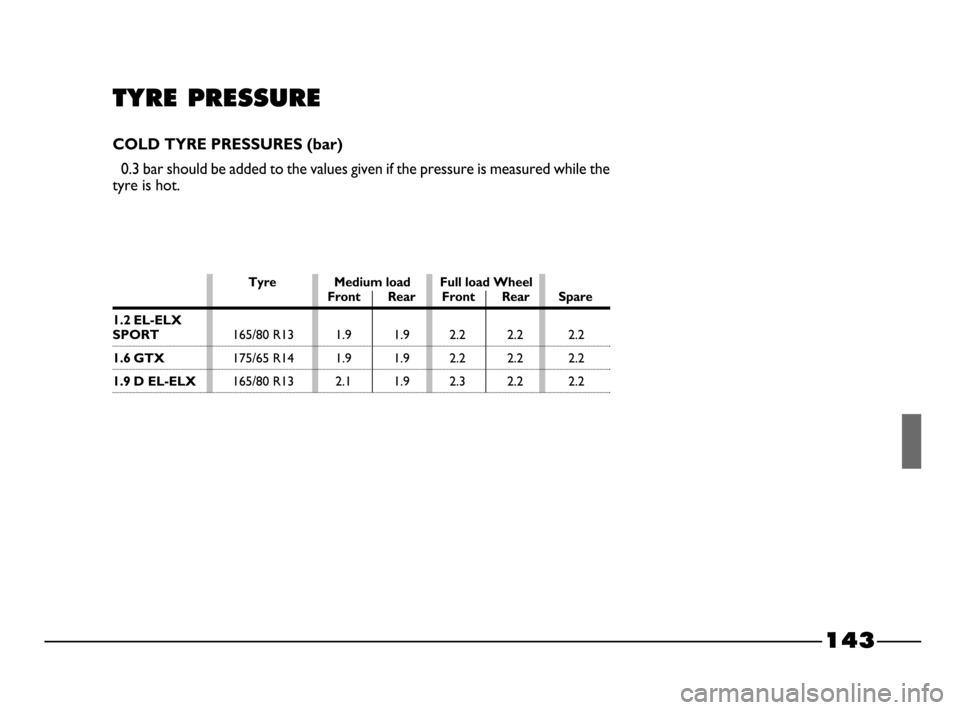
143
TYRE PRESSURE
COLD TYRE PRESSURES (bar)
0.3 bar should be added to the values given if the pressure is measured while the
tyre is hot.
Tyre Medium load Full load WheelFront Rear Front Rear Spare
1.2 EL-ELX SPORT165/80 R13 1.9 1.9 2.2 2.2 2.2
1.6 GTX175/65 R14 1.9 1.9 2.2 2.2 2.2
1.9 D EL-ELX165/80 R13 2.1 1.9 2.3 2.2 2.2
128-143 03/03/2003 07:39 PM Page 143